Tác động của văn hóa và bầu không khí tổ chức đến sự gắn bó của người lao động tại doanh nghiệp viễn thông Việt Nam: Trường hợp của FPT Telecom
Trong bối cảnh cách mạng công nghiệp, nguồn nhân lực được coi là nguồn lực vô giá của
các doanh nghiệp ở bất kỳ lĩnh vực nào. Các nhà nghiên cứu và quản lý đều nỗ lực để làm rõ các
yếu tố quyết định đến sự gắn bó của người lao động, từ đó thắt chặt mối liên kết giữa nhân viên
và tổ chức. Bài viết này nhằm mục đích đánh giá tác động của văn hóa tổ chức và môi trường
đối với sự gắn bó của người lao động. Dữ liệu thu thập từ 277 nhân viên của FPT Telecom - một
công ty viễn thông nổi tiếng tại Việt Nam, được phân tích bằng các phương pháp định lượng
khác nhau như thống kê mô tả và phân tích mô hình phương trình cấu trúc. Các kết quả chỉ ra
rằng cả văn hóa doanh nghiệp và bầu không khí tổ chức đều ảnh hưởng tích cực đến sự gắn bó
của người lao động. Đặc biệt, văn hóa thị trường và văn hóa thứ bậc có ảnh hưởng mạnh nhất
đến sự gắn bó.
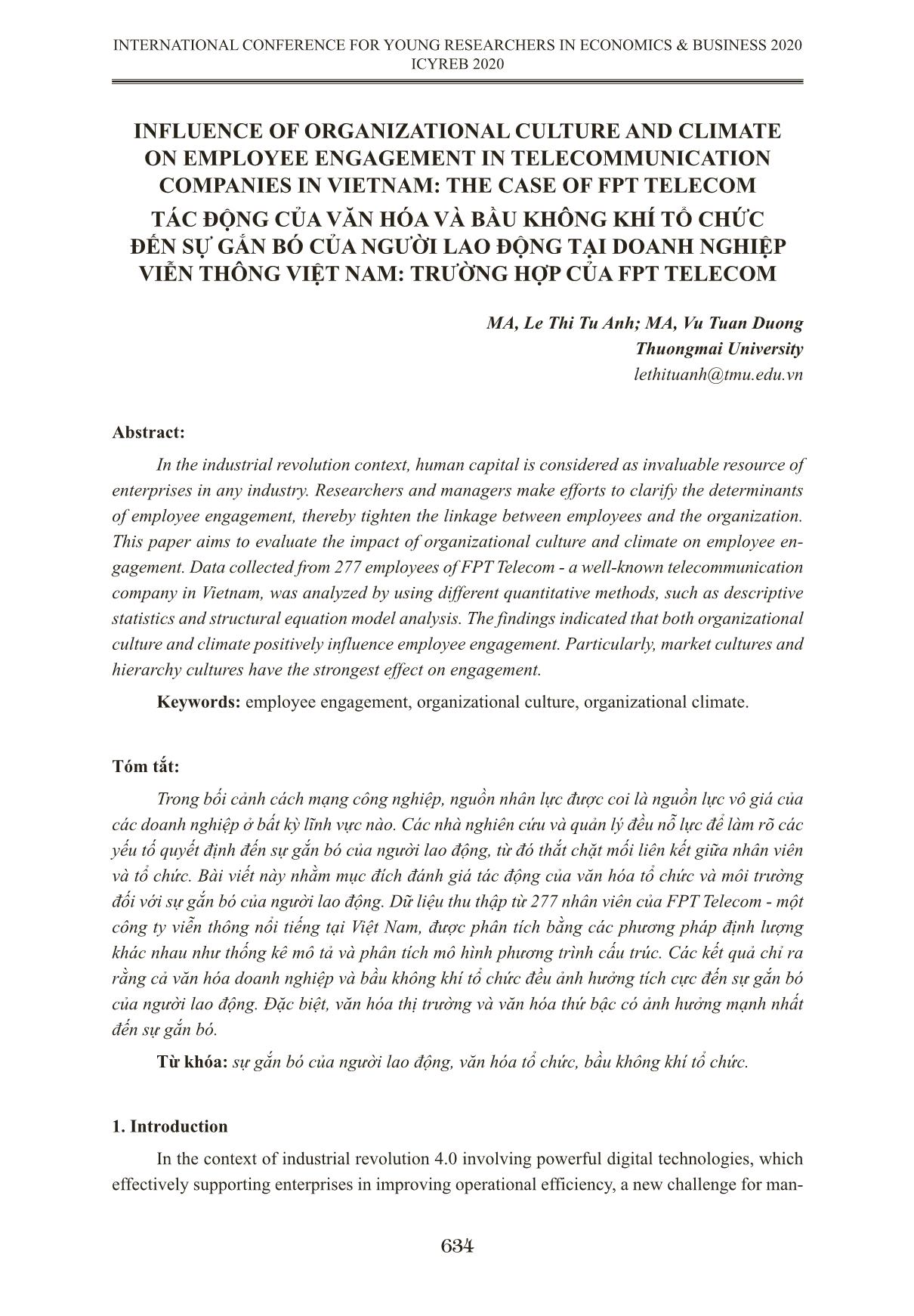
Trang 1
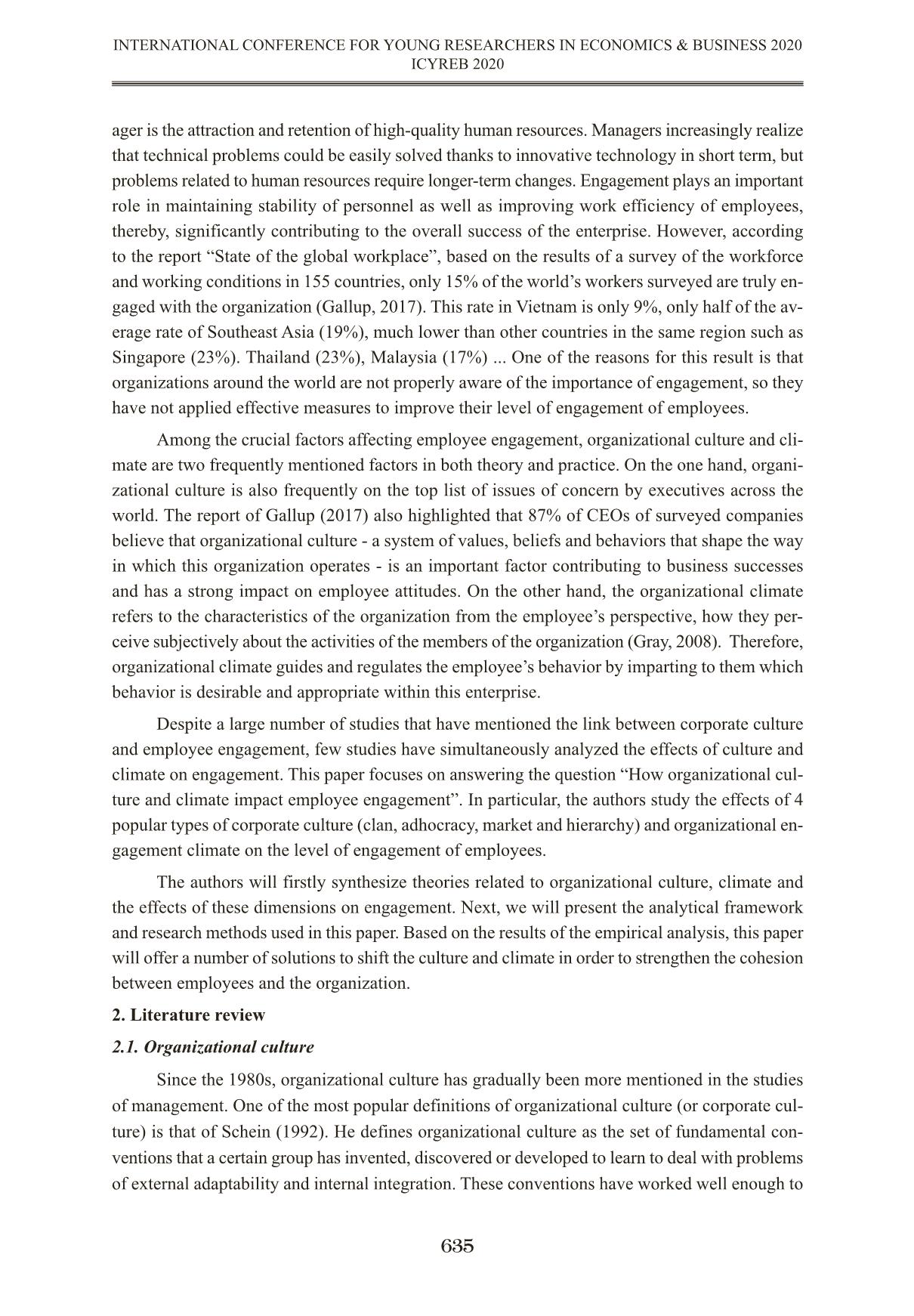
Trang 2
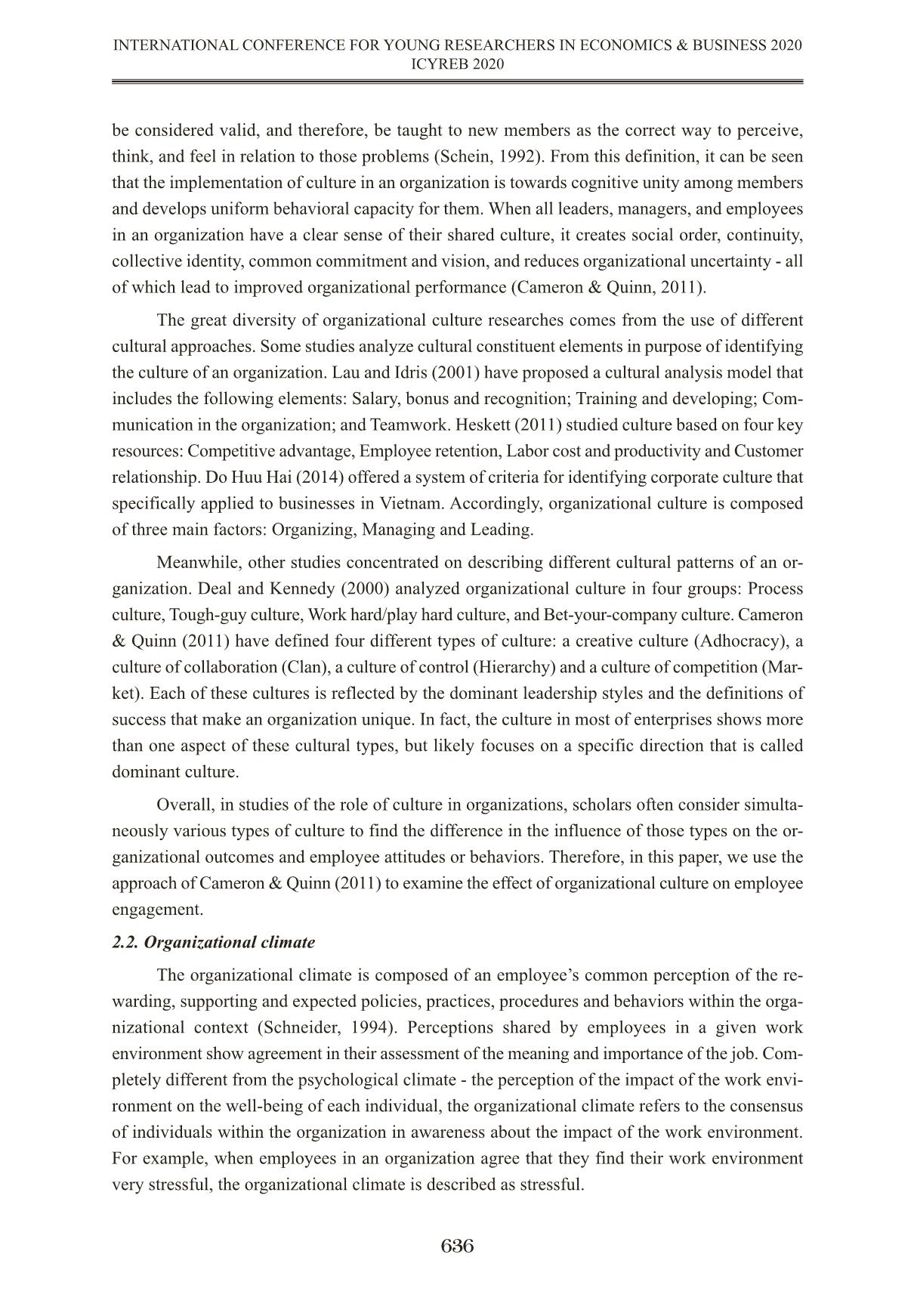
Trang 3
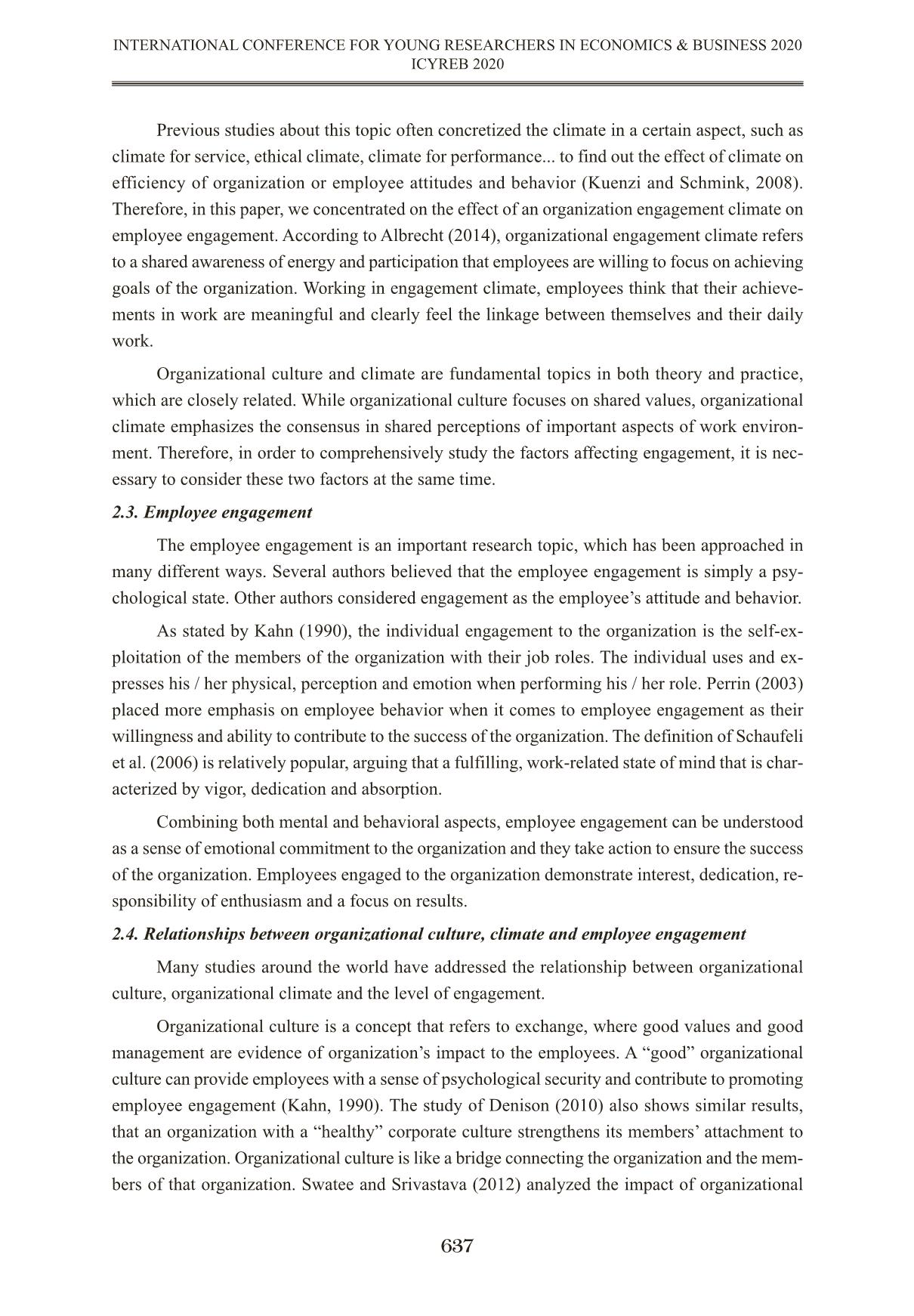
Trang 4
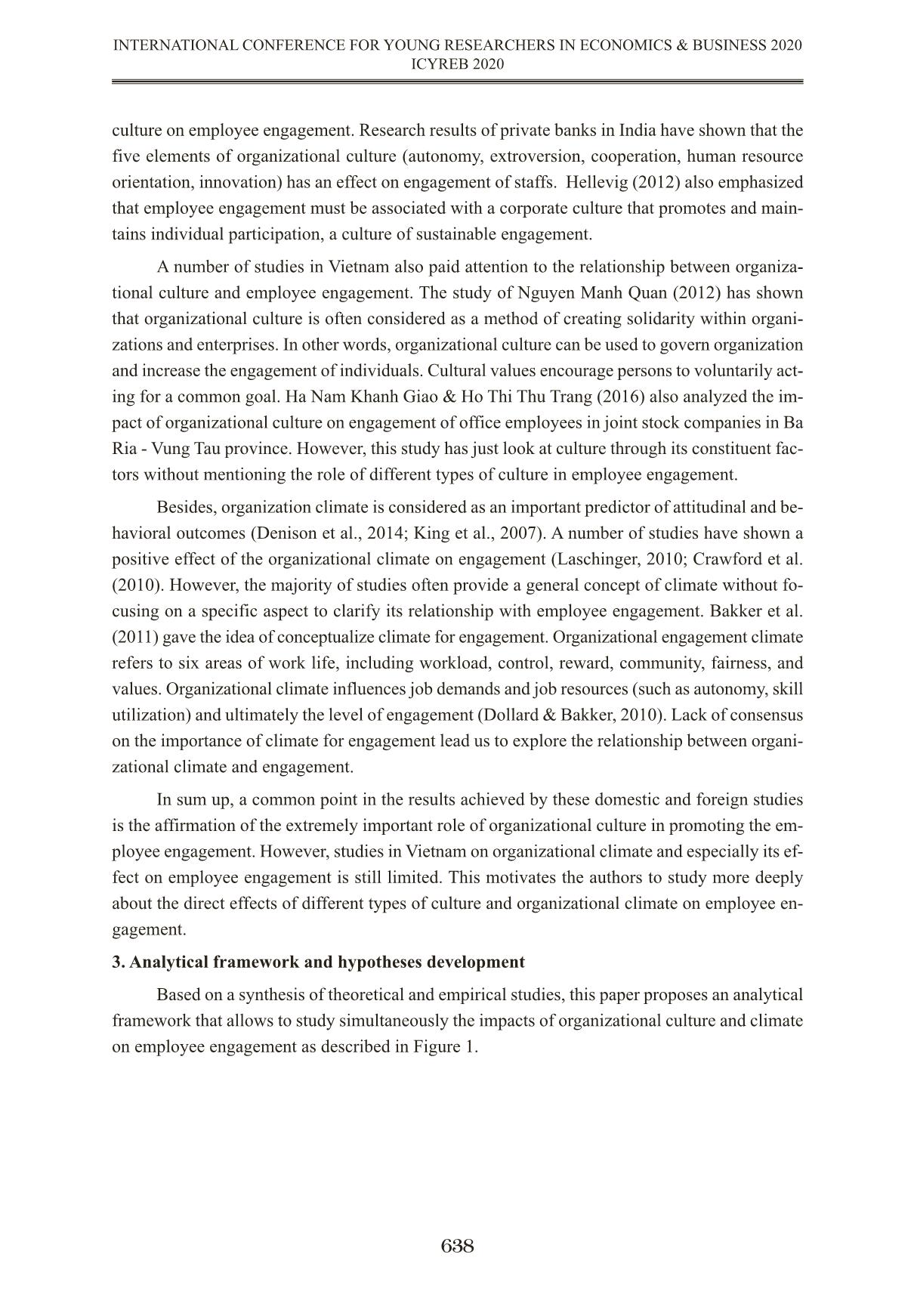
Trang 5
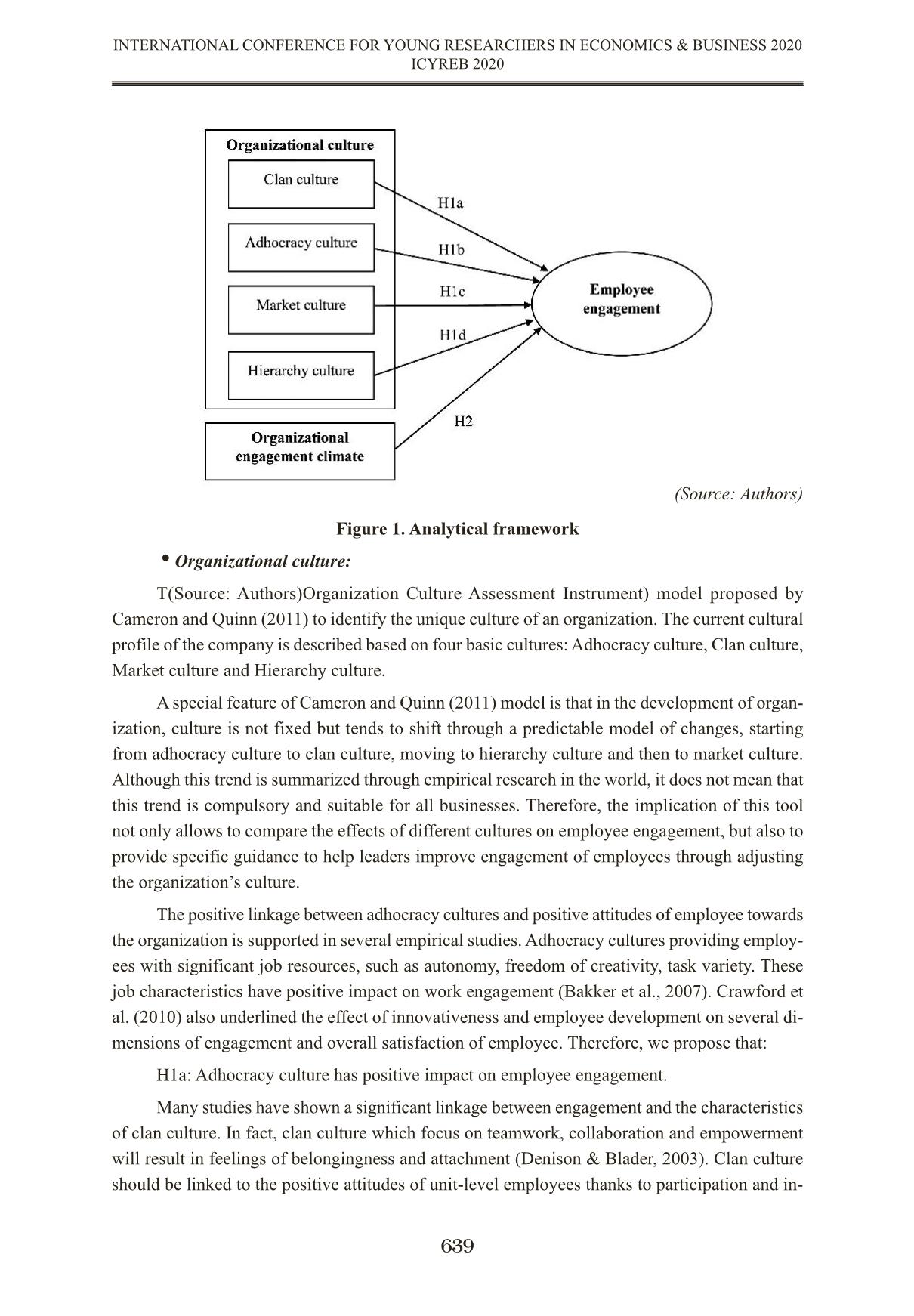
Trang 6
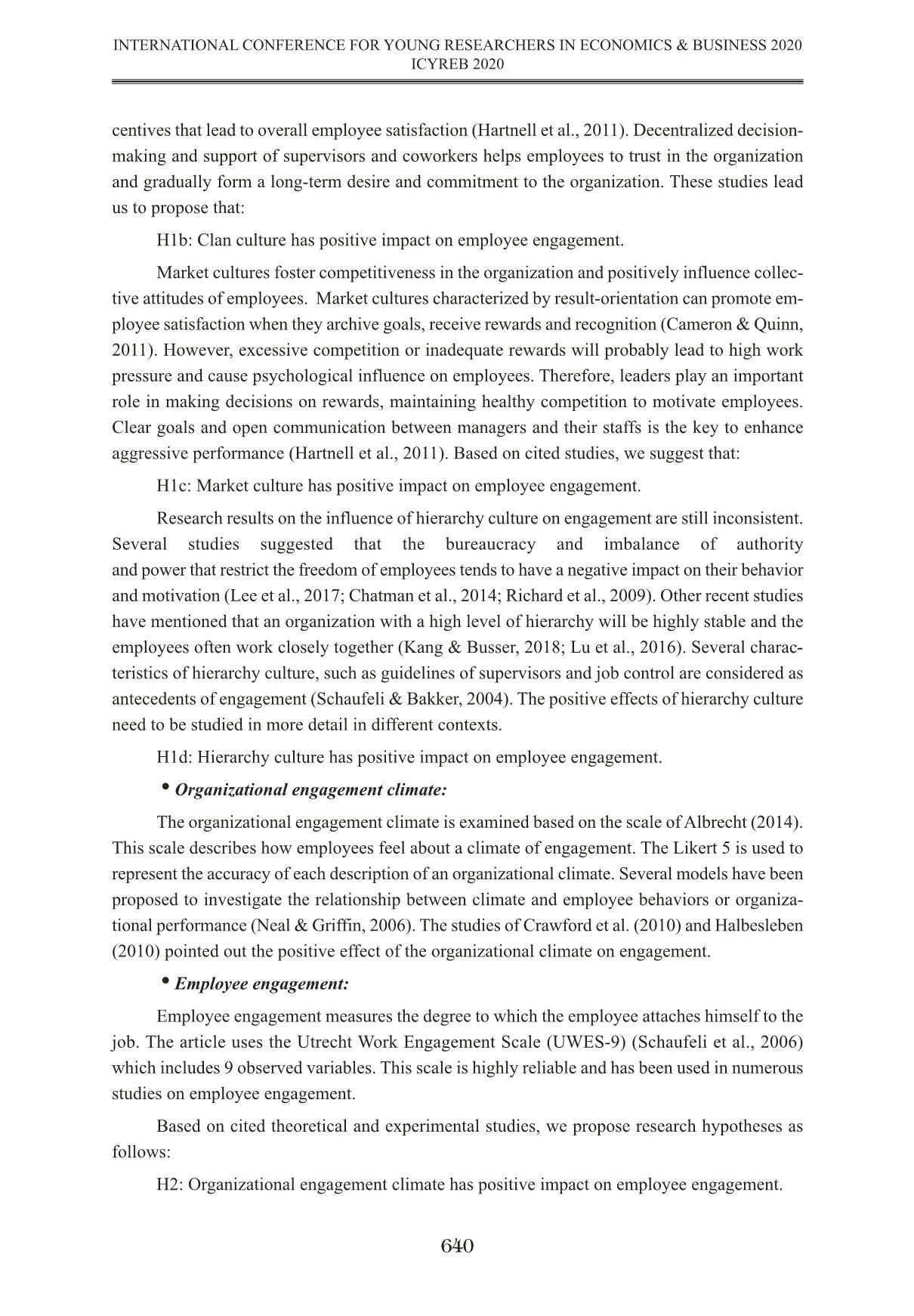
Trang 7
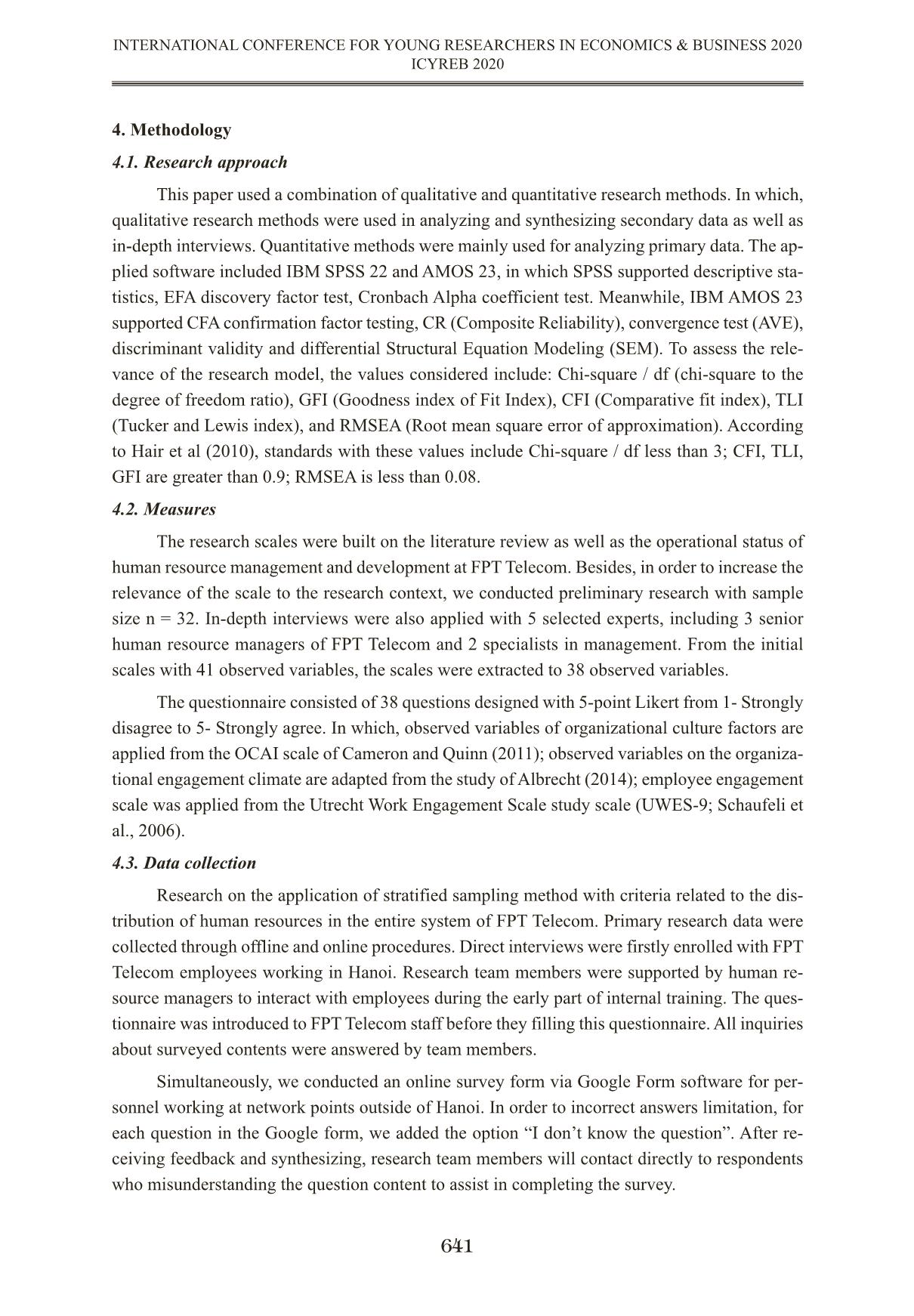
Trang 8
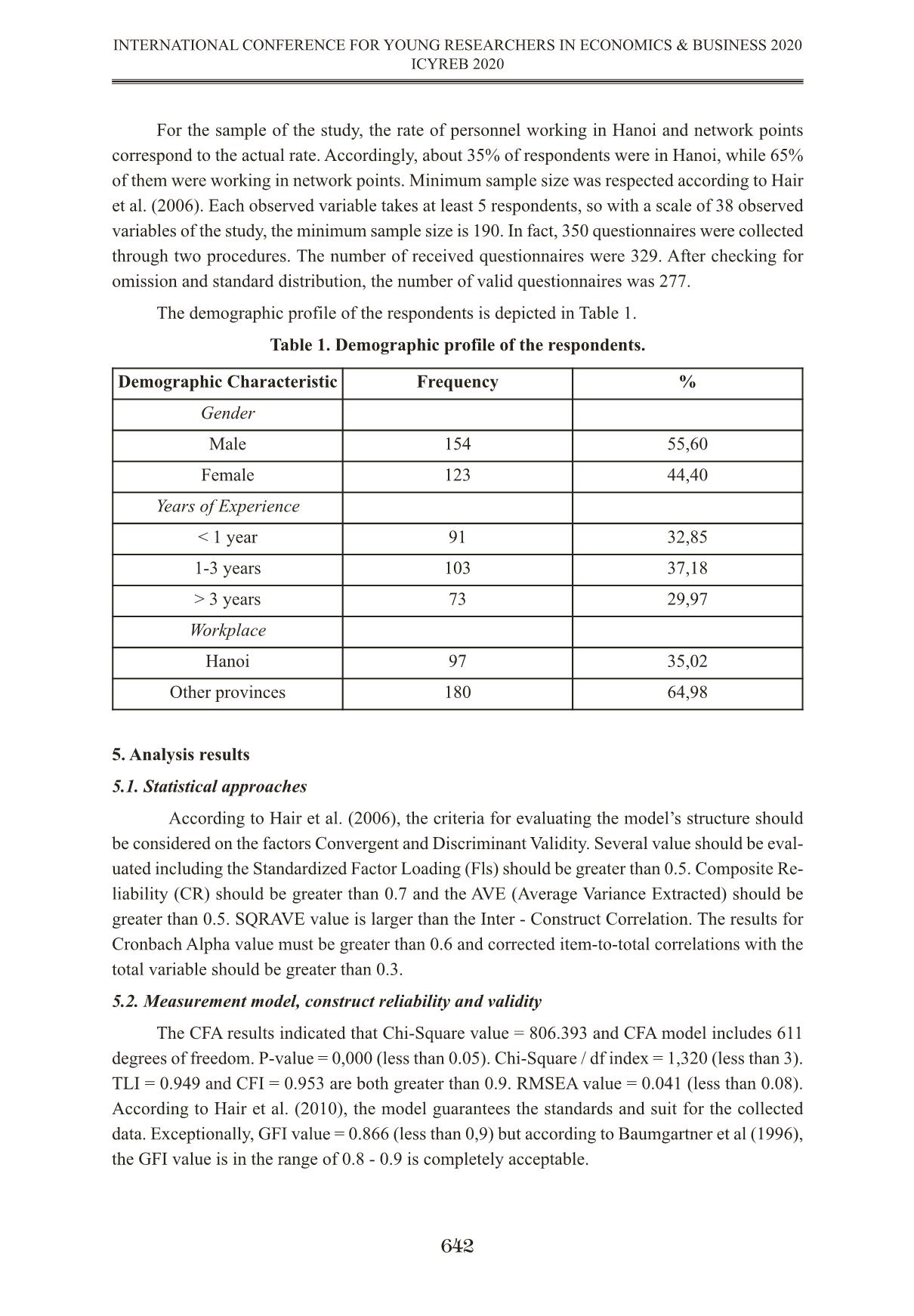
Trang 9
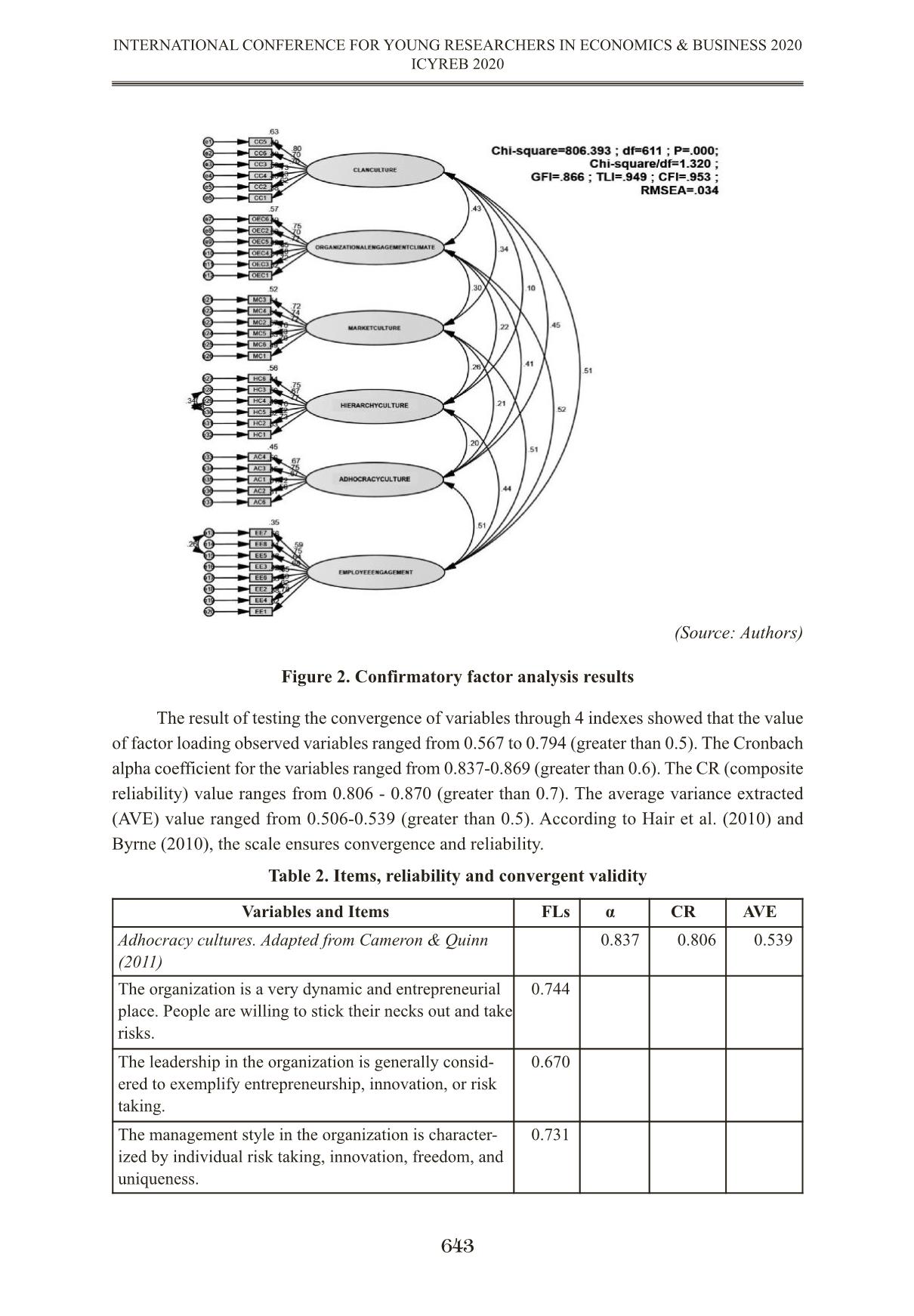
Trang 10
Tải về để xem bản đầy đủ
Tóm tắt nội dung tài liệu: Tác động của văn hóa và bầu không khí tổ chức đến sự gắn bó của người lao động tại doanh nghiệp viễn thông Việt Nam: Trường hợp của FPT Telecom
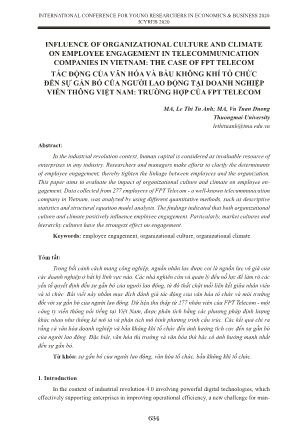
INFLUENCE OF ORGANIZATIONAL CULTURE AND CLIMATE ON EMPLOYEE ENGAGEMENT IN TELECOMMUNICATION COMPANIES IN VIETNAM: THE CASE OF FPT TELECOM TÁC ĐỘNG CỦA VĂN HÓA VÀ BẦU KHÔNG KHÍ TỔ CHỨC ĐẾN SỰ GẮN BÓ CỦA NGƯỜI LAO ĐỘNG TẠI DOANH NGHIỆP VIỄN THÔNG VIỆT NAM: TRƯỜNG HỢP CỦA FPT TELECOM MA, Le Thi Tu Anh; MA, Vu Tuan Duong Thuongmai University lethituanh@tmu.edu.vn Abstract: In the industrial revolution context, human capital is considered as invaluable resource of enterprises in any industry. Researchers and managers make efforts to clarify the determinants of employee engagement, thereby tighten the linkage between employees and the organization. This paper aims to evaluate the impact of organizational culture and climate on employee en- gagement. Data collected from 277 employees of FPT Telecom - a well-known telecommunication company in Vietnam, was analyzed by using different quantitative methods, such as descriptive statistics and structural equation model analysis. The findings indicated that both organizational culture and climate positively influence employee engagement. Particularly, market cultures and hierarchy cultures have the strongest effect on engagement. Keywords: employee engagement, organizational culture, organizational climate. Tóm tắt: Trong bối cảnh cách mạng công nghiệp, nguồn nhân lực được coi là nguồn lực vô giá của các doanh nghiệp ở bất kỳ lĩnh vực nào. Các nhà nghiên cứu và quản lý đều nỗ lực để làm rõ các yếu tố quyết định đến sự gắn bó của người lao động, từ đó thắt chặt mối liên kết giữa nhân viên và tổ chức. Bài viết này nhằm mục đích đánh giá tác động của văn hóa tổ chức và môi trường đối với sự gắn bó của người lao động. Dữ liệu thu thập từ 277 nhân viên của FPT Telecom - một công ty viễn thông nổi tiếng tại Việt Nam, được phân tích bằng các phương pháp định lượng khác nhau như thống kê mô tả và phân tích mô hình phương trình cấu trúc. Các kết quả chỉ ra rằng cả văn hóa doanh nghiệp và bầu không khí tổ chức đều ảnh hưởng tích cực đến sự gắn bó của người lao động. Đặc biệt, văn hóa thị trường và văn hóa thứ bậc có ảnh hưởng mạnh nhất đến sự gắn bó. Từ khóa: sự gắn bó của người lao động, văn hóa tổ chức, bầu không khí tổ chức. 1. Introduction In the context of industrial revolution 4.0 involving powerful digital technologies, which effectively supporting enterprises in improving operational efficiency, a new challenge for man- 634 INTERNATIONAL CONFERENCE FOR YOUNG RESEARCHERS IN ECONOMICS & BUSINESS 2020 ICYREB 2020 ager is the attraction and retention of high-quality human resources. Managers increasingly realize that technical problems could be easily solved thanks to innovative technology in short term, but problems related to human resources require longer-term changes. Engagement plays an important role in maintaining stability of personnel as well as improving work efficiency of employees, thereby, significantly contributing to the overall success of the enterprise. However, according to the report “State of the global workplace”, based on the results of a survey of the workforce and working conditions in 155 countries, only 15% of the world’s workers surveyed are truly en- gaged with the organization (Gallup, 2017). This rate in Vietnam is only 9%, only half of the av- erage rate of Southeast Asia (19%), much lower than other countries in the same region such as Singapore (23%). Thailand (23%), Malaysia (17%) ... One of the reasons for this result is that organizations around the world are not properly aware of the importance of engagement, so they have not applied effective measures to improve their level of engagement of employees. Among the crucial factors affecting employee engagement, organizational culture and cli- mate are two frequently mentioned factors in both theory and practice. On the one hand, organi- zational culture is also frequently on the top list of issues of concern by executives across the world. The report of Gallup (2017) also highlighted that 87% of CEOs of surveyed companies believe that organizational culture - a system of values, beliefs and behaviors that shape the way in which this organization operates - is an important factor contributing to business successes and has a strong impact on employee attitudes. On the other hand, the organizational climate refers to the characteristics of the organization from the employee’s perspective, how they per- ceive subjectively about the activities of the members of the organization (Gray, 2008). Therefore, organizational climate guides and regulates the employee’s behavior by imparting to them which behavior is desirable and appropriate within this enterprise. Despite a large number of studies that have mentioned the link between corporate culture and employee engagement, few studies have simultaneously analyzed the effects of culture and climate on engagement. This paper focuses on answering the question “How organizational cul- ture a ... gagement climate can explain 57% the variability of employee engage- ment. The remaining changes come from other factors that have not been included in this model. 646 INTERNATIONAL CONFERENCE FOR YOUNG RESEARCHERS IN ECONOMICS & BUSINESS 2020 ICYREB 2020 Constructs Mean SD EE CC MC HC AC OEC Employee engagement (EE) 4.331 0.863 0,710 Clan cultures (CC) 4.286 0.691 0,447 0,712 Market cultures (MC) 4.157 0.689 0,509 0,342 0,727 Hierarchy cultures (HC) 3.933 0.574 0,439 0,092 0,259 0,722 Adhocracy cultures (AC) 3.984 0.689 0,506 0,416 0,212 0,205 0,727 Organizational engagement climate (OEC) 4.277 0.600 0,523 0,456 0,299 0,221 0,405 0,709 (Source: Authors) Figure 3. SEM linear modeling results The results of structural equation analysis show that organizational culture and engagement climate significantly affect employee engagement at 0.01 level. In particular, the results show that market cultures and hierarchy cultures have the strongest impact on Employee Engagement with b = 0.26. clan culture has the weakest influence on engagement, with the coefficient of 0.206 while the remaining factors have an almost equivalent effect on engagement. In more detail, adhocracy cultures and organizational engagement climate impacts engage- ment with b of 0.220 and 0.210 respectively. Table 4. Results of the structural model (Source: Authors) In summary, all of five hypotheses were supported suggesting that organizational culture and engagement climate both have positive impact on employee engagement (Table 4). 647 INTERNATIONAL CONFERENCE FOR YOUNG RESEARCHERS IN ECONOMICS & BUSINESS 2020 ICYREB 2020 Hypothesized path Standardizedcoefficients t P Decision Adhocracy cultures g Employee engagement 0.220 3.179 0.001 Supported Clan cultures g Employee engagement 0.206 3.013 0.003 Supported Market cultures g Employee engagement 0.263 4.117 0.000 Supported Hierarchy cultures g Employee engagement 0.260 4.275 0.000 Supported Organizational en- gagement climate g Employee engagement 0.210 3.164 0.002 Supported 6. Discussions and implications Our findings support the significant impact of organizational culture and engagement cli- mate on employee engagement. This paper has contributed to literature as compared to previous studies that only examined separately culture and climate on employee engagement. Discussions of key findings and several implications for managers are summarized below. First of all, regression analysis result highlights the important role of four culture types and organizational engagement climate in engagement improvement. This study provides prac- titioners validated and reliable measurement scales for identifying organizational culture, evalu- ating perceived climate and determining engagement levels of employee. From there, managers can apply the OCAI model for culture shift in the desired direction. The application of these scales and OCAI model not only support human resource management activities, improve lead- ership effectiveness, but also create significant changes in the organization through adjusting the way the organization operates (organizational culture) and enhancing employee clarity about or- ganization’s goals, strategies (organizational climate). Secondly, the influence of organizational culture on employee engagement varies by types of culture. This result is consistent with majority of previous studies (Naidoo, 2014; Martin & Cullen, 2006). Perceived positive cultures are related to higher level of engagement. Interestingly, clan culture has weakest impact on employee engagement. Higher level of engagement is still linked with a cultural context that is people oriented and supportive, but effect of this culture style is the least important in comparison with market or hierarchy culture. This result is different with the analysis results of Hartnell et al. (2011), whereby, clan culture plays the most significant role in promoting work engagement. This can be explained based on the difference in the business sector surveyed. Hartnell et al. (2011) examined engagement in health organizations, within which cooperation is highly valued, a prerequisite for effective and long-term work. It’s also noticeable that hierarchy culture positively impacted employee engagement. In contrast to study of Lee et al. (2017), Chatman et al. (2014) and Richard et al. (2009) which in- sisted the negative linkage between hierarchy culture and work engagement, our study highlights that standardization, enforcement of rules and procedures will not restrict employee’s creativity and could increase employee engagement. Managers are coordinators and maintain the organi- zation’s regular functioning towards efficiency and stability. This result suggests to businesses, especially those in the information technology sector, to change their culture in purpose of promoting employee engagement, ultimately enhancing their work performance. Cultural transformation is inevitable but can still be managed to align with the organization’s goals and strategies. For telecommunication companies, developing market culture can both strengthen the linkage between employees and the organization, and create a healthy competitive environment for individuals to strive to achieve their goals and show their superiority. Thirdly, organizational engagement climate had positive relationship with employee en- gagement. Similar to theoretical researches, organizational climate is a potential driver of em- ployee’s motivation and positive attitude and behavior at work. This paper provides further evidence on the necessary to expand climate approaches. Previous studies have only focused on the importance of the climate of innovation, service or safety in organization effectiveness and 648 INTERNATIONAL CONFERENCE FOR YOUNG RESEARCHERS IN ECONOMICS & BUSINESS 2020 ICYREB 2020 employee performance (Kang & Busser, 2018; Kuenzi and Schmink, 2008). Both researchers and practitioners should pay more attention to climate of engagement to encourage employees to truly engage in work and organization. This result suggests the importance of creating an open and friendly climate in the workplace to influence employee perceptions and to make them more willing to devote to their work and organization. In spite of providing additional evidence of the relationship between organizational culture, climate and employee engagement, this paper exists certain limitations. The sample survey scope is still relatively narrow and only focuses on telecommunication field. Therefore, future studies could address this limitation by expanding the scope of the research with different sectors. 7. Conclusions In the context of technological explosion and increasing competition in the market, orga- nizational culture helps each company to create its own identity and become an undeniable com- petitive advantage. In addition, the organizational climate also created positive changes in employee’s attitudes and behaviors. With the aim of clarifying the impact of organizational culture and climate on employee engagement, the authors conducted a survey through questionnaires for the employees of a telecommunications company in Vietnam. The analysis results showed that both organizational culture and climate are important in promoting employee engagement. This paper not only provided additional empirical evidence for literature on drivers of engagement, it also offered significant suggestions for managers to actively change the culture and climate to retain employees. Like others studies, this paper still has limitations related to sample represents since we have focused on employees working within the same Vietnamese telecommunication company. Future studies should enlarge the sample or conduct cross-field research for validity enhancement. REFERENCES Albrecht, S.L. (2014), ‘A climate for engagement: some theory, models, measures, research, and practical applications’, in Schneider, B. and Barbera, K. (Eds), The Oxford Handbook of Or- ganizational Climate and Culture, Oxford University Press, Oxford, pp. 400-413. Bakker, A.B., Albrecht, S.L. and Leiter, M.P. (2011), ‘Key questions regarding work en- gagement’, European Journal of Work and Organizational Psychology, Vol. 20 No. 1, pp. 4-28 Bakker, A. B., Demerouti, E., Hakanen, J. J., & Xanthopoulou, D. (2007), ‘Job Resources boost work engagement, particularly when job demands are high’, Journal of Educational Psy- chology, 99, 274-284. Baumgartner, H., & Homburg, C. (1996), ‘Applications of structural equation modeling in marketing and consumer research: A review’, International journal of Research in Marketing, 13(2), 139-161. Cameron, K.S., & Quinn, R.E. (2011), ‘Diagnosing and changing organizational culture: Based on the competing values framework’, Reading, MA: Addison-Wesley. Deal T.E and Kennedy A.A (2000), ‘Corporate Cultures’, Reading, MA: Addison-Wesley. Chatman, J. A., Caldwell, D. F., O’Reilly, C. A., & Doerr, B. (2014), ‘Parsing organizational 649 INTERNATIONAL CONFERENCE FOR YOUNG RESEARCHERS IN ECONOMICS & BUSINESS 2020 ICYREB 2020 culture: How the norm for adaptability influences the relationship between culture consensus and financial performance in high-technology firms’, Journal of Organizational Behavior, 35, 785–808. Crawford, E.R., Lepine, J.A. and Rich, B.L. (2010), ‘Linking job demands and resources to employee engagement and burnout: a theoretical extension and meta-analytic test’, Journal of Applied Psychology, Vol. 95 No. 5, pp. 834-848. Denison, D.R. (1990), ‘Corporate culture and organizational effectiveness’, New York, John Wiley. Do Huu Hai (2014) ‘Hệ thống tiêu chí nhận diện văn hoá doanh nghiệp - Vận dụng cho doanh nghiệp Việt Nam’, Doctoral Thesis, National Economics University, Vietnam. Dollard, M.F., & Bakker, A. B. (2010), ‘Psychosocial safety climate as a precursor to con- ducive work environments, psychological health problems, and employee engagement’, Journal of Occupational and Organizational Psychology, 83, 579–599. Gallup (2017), ‘State of the global workplace’, New York. Gray, R. (2008), ‘How it feels to work here: Improving organizational climate, the inter- national journal of knowledge’, The International Journal of Knowledge Culture and Change Management Annual Review, 8(9), 85–91. Ha Nam Khanh Giao & Ho Thi Thu Trang (2016) Ảnh hưởng của văn hóa tổ chức đến sự gắn kết của nhân viên văn phòng tại tỉnh Bà Rịa – Vũng Tàu, Journal of Economic and Engi- neering, 14, 39-49. Hair, J. F., Black, W. C., Babin, B. J., Anderson, R. E., & Tatham, R. L. (2006), ‘Multivari- ate data analysis’, Vol. 6, Upper Saddle River, NJ: Pearson Prentice Hall. Hair, J.F., Black, W.C., Babin, B.J. and Anderson, R.E. (2010), ‘Multivariate Data Analy- sis’, 7th Edition, Pearson, New York. Halbesleben, J.R.B. (2010), ‘A meta-analysis of work engagement: relationships with burnout, demands, resources, and consequences’, in Bakker, A.B. and Leiter, M.P. (Eds), Work Engagement: A Handbook of Essential Theory and Research, Psychology Press, New York, NY, 102-117. Hartnell, C. A., Ou, Y. O., & Kinicki, A. (2011), ‘Organizational Culture and Organizational Effectiveness: A Meta-Analytic Investigation of the Competing Values Framework’s Theoretical Suppositions’, Journal of Applied Psychology, 96(4), 677-694. Heskett, J. (2011), ‘The culture cycle: How to shape the unseen force that transforms per- formance’, FT Press, Upper Saddle River. Kahn, W.A. (1990), ‘Psychological conditions of personal engagement and disengagement at work’, Academy of Management Journal, 33. Kang, H. J., & Busser, J. A. (2018), ‘Impact of service climate and psychological capital on employee engagement: The role of organizational hierarchy’, International Journal of Hos- pitality Management, 75, 1–9. 650 INTERNATIONAL CONFERENCE FOR YOUNG RESEARCHERS IN ECONOMICS & BUSINESS 2020 ICYREB 2020 King, E. B., de Chermont, K., West, M., Dawson, J. F., & Hebl, M. (2007), ‘How innovation can alleviate negative consequences of demanding work contexts: the influence of climate for innovation on organizational outcomes’, Journal of Occupational and Organizational Psychol- ogy, 80, 631–645. Kuenzi, M. & Schmink, M. (2008), ‘An integrated model of work climate’, paper presented at annual meeting of the Academy of Management, Anaheim, CA. Laschinger, H. K. S. (2010), ‘Staff nurse work engagement in Canadian hospital settings: the influence of empowerment and six areas of worklife’, In S.L. Albrecht (Ed.), Handbook of employee engagement: perspectives, issues, research and practice (pp. 309–322). Cheltenham, UK: Edward Elgar. Lau, H. C., & Iris, M. A. (2001), ‘The soft foundation of the critical success factors on TQM implementation in Malaysia’, The TQM Magazine, 13(1), 51 - 62. Lee, M. C. C., Idris, M. A., & Delfabbro, P. H. (2017), ‘The linkages between hierarchical culture and empowering leadership and their effects on employees’ work engagement: Work meaningfulness as a mediator’, International Journal of Stress Management, 24(4), 392–415. Lu, L., Lu, A.C.C., Gursoy, D., Neale, N.R. (2016), ‘Work engagement, job satisfaction, and turnover intentions: a comparison between supervisors and line-level employees’, Interna- tional Journal of Contemporary Hospitality Management, 28 (4), 737–761. Martin, K. D., & Cullen, J.B. (2006), ‘Continuities and extensions of ethical climate theory: A Meta-Analytic Review’, Journal of Business Ethics, 69, 175-194. Naidoo, P. (2014), ‘Investigating the relationship between organizational culture and work engagement’, Problems and Perspectives in Management, 12(4), 432-440. Nguyen Manh Quan (2012), ‘Chuyên đề Văn hóa doanh nghiệp’, Bộ Kế hoạch và Đầu tư. Perrin, T. (2003), ‘Working today: Understanding what drives employee engagement’. Richard, O. C., McMillan-Capehart, A., Bhuian, S. N., & Taylor, E. C. (2009), ‘Antecedents and consequences of psychological contrats: Does organizational culture really matter?’, Journal of Business Behavior, 62, 818-825. Schaufeli, W.B., Bakker, A.B. and Salanova, M. (2006), ‘The measurement of work en- gagement with a short questionnaire: a cross-national study’, Educational and Psychological Measurement, Vol. 66 No. 4, pp. 701-716. Schein, E. (1992), ‘Organizational Culture and Leadership: A Dynamic View’, San Francisco, CA: Jossey-Bass. Schneider, W. (1994), ‘The Reengineering Alternative: A Plan for Making Your Current Culture Work’, Burr Ridge, IL: Irwin Professional Publishing. Swatee, S. & Srivastava, R.K. (2012), ‘Impact of organizational culture and communication on employee engagement: An investigation of Indian privates banks’, South Asian Journal of Management, 19(3), 18-33. 651 INTERNATIONAL CONFERENCE FOR YOUNG RESEARCHERS IN ECONOMICS & BUSINESS 2020 ICYREB 2020
File đính kèm:
 tac_dong_cua_van_hoa_va_bau_khong_khi_to_chuc_den_su_gan_bo.pdf
tac_dong_cua_van_hoa_va_bau_khong_khi_to_chuc_den_su_gan_bo.pdf

